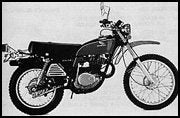 THE TRIALS FLOP 250 STYLE
THE TRIALS FLOP 250 STYLE
Everybody babbled about how hot the sport of trials was in 1975, and all of the major manufacturers brought out 250 trials bikes. The purists in the sport continued buying their Spanish bikes and made fun of anyone who showed up on a Japanese trials bike, even though major teams were fielded. The TL250 Trials by Honda, a trim four-stroke, languished on the showroom floors like all the rest. The boom turned out to be a bust, in spite of all of the Japanese trials bikes being solid, reliable units.
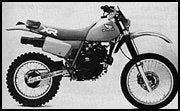 A DECENT ENDURO BIKE
A DECENT ENDURO BIKE
In 1976, an enduro version of the Elsinore, the MR250, appeared on the scene. It had a big 3.4-gallon tank, lights, quiet muffler, real knobby tires, wide-ratio gearbox and shared many of the same parts as the pure racing Elsinore. Many enduro and desert riders modified the MRs with CR parts and loved their mounts. Strangely, the MR was in production only one year.
Time passed (as it has a way of doing) and 1978 was suddenly upon us. And with that year came the 1978 CR250R Elsinore with the laydown shocks and long travel at both ends. They called it the Red Rocket and, indeed, it was fast. It looked sleek and very works-like, and riders beat each other with clu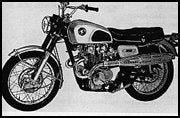 bs to get the first ones on the showroom floors. Honda also cranked up their national racing team efforts at a crazed pace during this time frame, making instant legends out of numerous riders.
bs to get the first ones on the showroom floors. Honda also cranked up their national racing team efforts at a crazed pace during this time frame, making instant legends out of numerous riders.
A GREAT ENDURO BIKE
A very solid bike appeared unexpectedly in 1979 and put a dent in the XL sales. The XR250 was an enduro-ready bike with less weight and clutter than the street-legal XL. The only strange thing about it was the 23-inch front wheel, a fad that lasted two short years. Still, the bike was good and had plenty of potential for responding to minor hop-ups. With a good pair of shocks and some weekend tuning, they started winning enduros and hare scrambles.
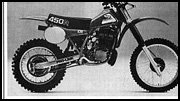 In 1981, a single-shocked version of this model was an instant hit. Again, oddly, they went with an off-size wheel, this time a 17-inch rear for some unexplained reason.
In 1981, a single-shocked version of this model was an instant hit. Again, oddly, they went with an off-size wheel, this time a 17-inch rear for some unexplained reason.
STRANGE THINGS
After three years of no change, Honda went berserko in 1981 and made one of the all-time flopperoos of the ‘80s. The ‘81 Elsinore was water-cooled, single-shocked and had more trick features on it than a space shuttle. Unfortunately, it was also ill-handling and stalled easier than a first-date proposal.
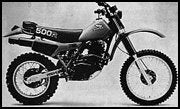 Next year, they got better, but ran head-on into the 1982 Suzuki RM250 and got plowed under the back 40 without the benefit of a military funeral.
Next year, they got better, but ran head-on into the 1982 Suzuki RM250 and got plowed under the back 40 without the benefit of a military funeral.
THE HANNAH YEARS
Bob Hannah moved from Yamaha to Honda in 1983, and Honda moved from a bland bike to a great one. The CR250R for ‘83 not only did it right, they did it when all the other 250s (with the sole exception of KTM's 250) stepped in a nuclear cow-pie. Even Suzuki showed suicidal tendencies with their ‘83 versions, turning last year's missile into a mistake.
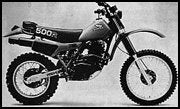 Bad news for 1985. In an attempt to come up with a bike to compete against the punchy YZ250 powerband, they brought out a CR250 that put out a nasty little burst right off idle, then signed off and turned into a snail. It also shook the steering head like a snake on a hotplate, stalled easier than a window fan with a shoe stuck in it, had a shock that faded riding to the starting line, confused jetting, no horsepower, limp forks and a gearbox that shredded gears like popcorn.
Bad news for 1985. In an attempt to come up with a bike to compete against the punchy YZ250 powerband, they brought out a CR250 that put out a nasty little burst right off idle, then signed off and turned into a snail. It also shook the steering head like a snake on a hotplate, stalled easier than a window fan with a shoe stuck in it, had a shock that faded riding to the starting line, confused jetting, no horsepower, limp forks and a gearbox that shredded gears like popcorn.
Aftermarket folks were able to turn it into a competitive bike, but the cost was staggering; 1985 will not be remembered fondly for a memorable 250CR.
In 1987, Honda put it all together for a truly brilliant 250 racer. The ‘87 CR had the best set of cartridge forks ever, including current models. Disc brakes appeared at both ends, the rear suspension was decent (and approached perfection with an aftermarket shock) and the motor did it all, pulling strong and smooth everywhere.
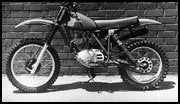 Whoops! The very next year, they screwed up the 1987 winner with a weak and confused Delta Link rear suspension, harsh forks and a wretched shock. Back to the drawing board.
Whoops! The very next year, they screwed up the 1987 winner with a weak and confused Delta Link rear suspension, harsh forks and a wretched shock. Back to the drawing board.
Since the Hannah years, the CR 250s have been refined steadily and have always had a seriously good motor, and also cursed with less than stellar suspension. A few years ago, they rocked the world with the first production aluminum frame for MXers with the CR line. They retain the rocket red looks and incredible attention to detail.
ALMOST A BIG BIKE: 251cc THROUGH 450cc
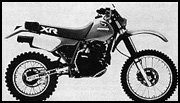 From 1965 through 1968, a bike called the CL77 305 Scrambler caught the fancy and the not-so-fancy of the public. Lots of them got stripped down, Snuff-Or-Nots were jammed in the exhaust tips and real knobby tires got wrapped around the rims. With open pipes, it emitted a bloodcurdling sound as the revs rose. The engine, a four-stroke twin, was as reliable as a claw hammer and the performance was exhilarating. Back then we never realized how truly bad they handled, because we were having too much fun.
From 1965 through 1968, a bike called the CL77 305 Scrambler caught the fancy and the not-so-fancy of the public. Lots of them got stripped down, Snuff-Or-Nots were jammed in the exhaust tips and real knobby tires got wrapped around the rims. With open pipes, it emitted a bloodcurdling sound as the revs rose. The engine, a four-stroke twin, was as reliable as a claw hammer and the performance was exhilarating. Back then we never realized how truly bad they handled, because we were having too much fun.
The 305 was replaced in 1968 with a much more serious version, the CL350 Scrambler. Trimmer, slimmer and much more dirt-oriented, this rig got stripped, hopped-up and tuned for racing just about everywhere from the desert to the TT tracks of the nation. And guess what? It did great. Many a Baja event was won from the saddle of a 350 Scrambler. Even though the 350 Scrambler hung around for another five years, it was put on the back burner by the 1969 SL350 Motosport, 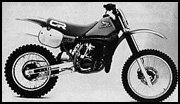 a 325cc four-stroke twin that came with dirt tires and styling. Many magazines wrote it off as yet another overweight, useless Honda pseudo-dirt bike. However, I went back to a national enduro in Ohio and saw several of these units being used quite well in the water and mud. Strip some of the junk off them, slip on some good tires and shocks and they would go anywhere and keep on running with little or no maintenance. They provided many a rider with affordable fun and we gained a new respect for the SL350.
a 325cc four-stroke twin that came with dirt tires and styling. Many magazines wrote it off as yet another overweight, useless Honda pseudo-dirt bike. However, I went back to a national enduro in Ohio and saw several of these units being used quite well in the water and mud. Strip some of the junk off them, slip on some good tires and shocks and they would go anywhere and keep on running with little or no maintenance. They provided many a rider with affordable fun and we gained a new respect for the SL350.
BIGGER XLs
The XL350 four-stroke single appeared in 1974. In stock trim, it was ponderous, ill-handling and boring. But with some clever work, many of them were turned into fine dirt bikes. Some riders spent buckets of money on trick frames and hyper engines, but as nice as these machines were to ride, they were very unreliable when heavily tweaked. A single-shocked pair of 350s were offered to the public in 1984, the XL and XR 350. They were immediate hits and also filled out Honda's four-stroke line completely. In the real world of performance, though, the 250 was a superior bike in most conditions. The last vestiges of the bloated 1968 CL450 Scrambler hung around until 1974 and the K6 model. It was a 444cc twin four-stroke DOHC with huge chromed high pipes loaded with excess weight and more chrome than a toaster plant.
FIRST BIG TWO-STROKE
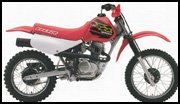 For years, the public had been demanding a real big-bore racer from Honda. Jeez, every other builder had one why not Big Red? So, in 1981, they brought out with great fanfare the CR450R Elsinore. A few magazines wrote wonderful things about it: “Cat-quick and grizzly-tough'' and “The best Open class MXer ever built.” That kind of stuff.
For years, the public had been demanding a real big-bore racer from Honda. Jeez, every other builder had one why not Big Red? So, in 1981, they brought out with great fanfare the CR450R Elsinore. A few magazines wrote wonderful things about it: “Cat-quick and grizzly-tough'' and “The best Open class MXer ever built.” That kind of stuff.
When I tested a CR450R (actually a 431cc bike), I was shocked and disappointed. The R came with a four-speed gearbox that was always in the wrong place at the awkward time. No combination of gearing let it work comfortably. It stalled easily, moved around like rubber ice skates, shook the steering head like someone had left out the bearings and the rear end hopped around madly after the shock faded, which took about eight minutes of hard riding. It also had a front number plate that looked like a giant hangnail.
THE BIG FOUR -STROKES
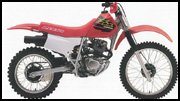 Two important models were made available in 1979, the XR500 and the XL500S. Both were powered by a 498cc four-valve single and both had another strange front wheel: a 23-incher. They were heavy, but powerful, and both received all sorts of modifications.
Two important models were made available in 1979, the XR500 and the XL500S. Both were powered by a 498cc four-valve single and both had another strange front wheel: a 23-incher. They were heavy, but powerful, and both received all sorts of modifications.
Many XL owners stripped their bikes down and kept the license plate on it, using it for day-to-day transportation as well as trail riding. It was one of the few street-legal bikes that could cruise comfortably with high-speed traffic.
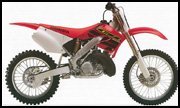 In 1981, the XR500 got the single shock treatment and I bought one to use as a project bike. It got a C&J frame, every engine mod available and the best suspension components available. We built it so hyper that all it did was blow up.
In 1981, the XR500 got the single shock treatment and I bought one to use as a project bike. It got a C&J frame, every engine mod available and the best suspension components available. We built it so hyper that all it did was blow up.
I'd fix it, then blow it up and fix it and blow it up again, until I got sick of looking at it.
Honda got out the boring bar for the XL500 and made it into the XL600R in 1983. Some riders loved them and others hated them, but they sure made an impact. By 1985 you could buy a 600cc XR.
Al Baker and a few others learned how to modify the 600s for relatively low bucks and turned more than a few into Baja winners. With good suspension parts and thoughtful engine tuning, the XR remained heavy, but had enough pure horsepower to work well at GPs and cross-country racing. A steady evolvement of the big XR continues to this very day and they are still tall, fast, heavy and reliable bikes.
FINALLY, A GOOD BIG-BORE TWO-STROKE
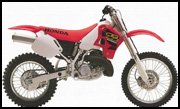 A proper big-bore racer finally appeared in 1982. The ill-fated 450 was happily gone and a decent CR480R replaced it. In spite of still being handicapped with a four-speed box, it was an excellent bike and got even better in 1983, when they refined it greatly and slipped in a five-speeder.
A proper big-bore racer finally appeared in 1982. The ill-fated 450 was happily gone and a decent CR480R replaced it. In spite of still being handicapped with a four-speed box, it was an excellent bike and got even better in 1983, when they refined it greatly and slipped in a five-speeder.
After a few solid years, the big Honda CR turned weird in 1984. The Ping King appeared, designated the CR500R. No one could get rid of the detonation, it stalled constantly, restarted when it felt like it and shook like a Slinky toy at high speeds over rough ground.
Once the CR500 got water-cooled, the very next year, it became a much better bike and has been getting small improvements right up to 2001.
THE DOMINATING FOUR STROKES
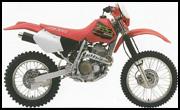 The ‘90s saw the continuing evolution of the XR600 (and its street legal brother the XL 650), but the wildly successful XR400 became the bike of choice for untold thousands of riders.
The ‘90s saw the continuing evolution of the XR600 (and its street legal brother the XL 650), but the wildly successful XR400 became the bike of choice for untold thousands of riders.
We saw the last of the XR600 last year, and of course, Honda brought out the mighty XR650 two years ago.
AND FINALLY…
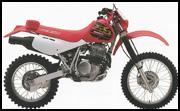 Yes, finally we got the long-awaited four-stroke motocross bike this year: the CR450R. It's a magnificent beast, sporting plenty of smooth power, and aluminum frame and the legendary Honda attention to detailing.
Yes, finally we got the long-awaited four-stroke motocross bike this year: the CR450R. It's a magnificent beast, sporting plenty of smooth power, and aluminum frame and the legendary Honda attention to detailing.
THE FUTURE?
Based on what Honda has done in the past, we continue to see the giant of the industry continue to take chances and break ground with their CR racers. No doubt there will be mistakes, as well as some brilliant models.
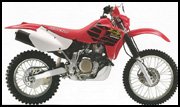 Clearly, four-strokes are the future with Honda dirt bikes, but we should see a limited number of two-strokes for closed-course specialty events, like Supercross.
Clearly, four-strokes are the future with Honda dirt bikes, but we should see a limited number of two-strokes for closed-course specialty events, like Supercross.
Whatever happens, Honda intends to remain in the Number One slot. As George Ethridge said back in 1973: We don't want to put everyone out of business. We just want to make them get better!


 Your Privacy Choices
Your Privacy Choices